History
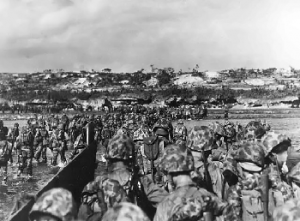 Every battle fought in a war is important, but some battles carried mush more weight, either in it’s strategic importance, or in it’s loss of life. Sometimes, a battle’s importance is due to both, as is the Battle of Okinawa, which was the largest and deadliest campaign in the Pacific Theater of World War II. The atomic bombings of Japan, which ended World War II in the Pacific Theater, were a direct result of battles undertaken on many key Pacific Ocean islands between the United States and its allies, and the Japanese forces. While these battles were bloody and deadly, costing many lives, they were nevertheless, of ultimate importance to the defeat of the Japanese Empire. The Battle of Okinawa, codenamed Operation Iceberg was the deadliest of the war.
Every battle fought in a war is important, but some battles carried mush more weight, either in it’s strategic importance, or in it’s loss of life. Sometimes, a battle’s importance is due to both, as is the Battle of Okinawa, which was the largest and deadliest campaign in the Pacific Theater of World War II. The atomic bombings of Japan, which ended World War II in the Pacific Theater, were a direct result of battles undertaken on many key Pacific Ocean islands between the United States and its allies, and the Japanese forces. While these battles were bloody and deadly, costing many lives, they were nevertheless, of ultimate importance to the defeat of the Japanese Empire. The Battle of Okinawa, codenamed Operation Iceberg was the deadliest of the war.
Following the December 7, 1941 Japanese attack on Pearl Harbor, Hawaii, the United States officially entered World War II. The United States had a score to settle, but at the onset things did not go well for the US. The Japanese kept expanding and conquering in the Pacific and seemed unstoppable. The United States and its allies rallied and were able to start gaining ground at the Battle of Midway in 1942, but it was the Battle of Okinawa that really changed things.
Military leadership realized that, because the Japanese controlled a vast area of the Pacific, taking over the many islands dotting the Pacific would be crucial to victory. They needed bases from which to launch the various operations against Japan, and these islands were perfect for it. American soldiers, sailors, and marines  fought over the next three years, on little islands in places many Americans had never heard of…places like Tarawa, Midway, Saipan, Luzon, and Cape Gloucester. Each battle, brought with it significant bloodshed. The Japanese fought ruthlessly to the end in all cases, refusing to surrender even in the face of obvious defeat. They would rather die than give up, and many did. It was the samurai code of Bushido, in which Japanese soldiers fought to the death because they believed in death before defeat. Slowly, the Allies began to push the Japanese off occupied islands and Japan started to run out of ships, planes, and soldiers as the war continued.
fought over the next three years, on little islands in places many Americans had never heard of…places like Tarawa, Midway, Saipan, Luzon, and Cape Gloucester. Each battle, brought with it significant bloodshed. The Japanese fought ruthlessly to the end in all cases, refusing to surrender even in the face of obvious defeat. They would rather die than give up, and many did. It was the samurai code of Bushido, in which Japanese soldiers fought to the death because they believed in death before defeat. Slowly, the Allies began to push the Japanese off occupied islands and Japan started to run out of ships, planes, and soldiers as the war continued.
As 1944 turned into 1945, the Japanese were pushed back onto what they considered their “home” territory on the Ryukyu Islands, one of which was Okinawa. This island was crucial to the American war strategy, because from there, they could successfully launch bombing raids on the Japanese homeland. On March 24, 1945 the US Navy launched artillery bombings and air raids on the island to weaken the forces located there. Eight days later, hundreds of thousands of soldiers landed on Okinawa’s beaches in what was called Operation Iceberg. Their mission was to capturing or destroy the island’s air bases. The original landing had 287,000 US troops versus 130,000 Japanese soldiers.
The fighting continued for two and a half months. The American soldiers fought in four critical areas of the island with specific strategies…take the eastern coast of the island, followed by the northern part, then take the 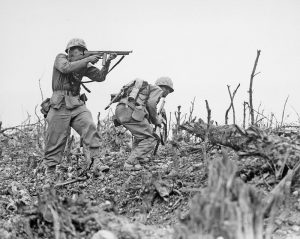 outlying islands surrounding Okinawa, and finally defeat the embedded Japanese troops. It all sounded pretty straightforward, but this battle was different. In this battle, the Japanese didn’t engage their enemies right on the beach, like they had in other battles. At Okinawa, they fell back into the jungles of the island to gain what little advantage they could as a defensive force. The Japanese used caves, pillboxes…fortified positions, and the jungle to their advantage. They also resumed a deadly tactic on the seas…kamikaze attacks. Brave pilots loaded their planes with high explosives and crashed into ships, destroying several, including their attached aircraft. Nevertheless, eventually the Allies won and Okinawa still houses an American base to this day.
outlying islands surrounding Okinawa, and finally defeat the embedded Japanese troops. It all sounded pretty straightforward, but this battle was different. In this battle, the Japanese didn’t engage their enemies right on the beach, like they had in other battles. At Okinawa, they fell back into the jungles of the island to gain what little advantage they could as a defensive force. The Japanese used caves, pillboxes…fortified positions, and the jungle to their advantage. They also resumed a deadly tactic on the seas…kamikaze attacks. Brave pilots loaded their planes with high explosives and crashed into ships, destroying several, including their attached aircraft. Nevertheless, eventually the Allies won and Okinawa still houses an American base to this day.
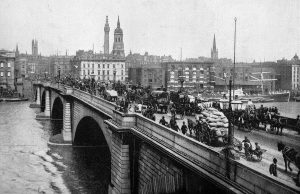
 They say that money can buy you just about anything…if you have enough of it. I suppose that in the area of material things, that might be true. Nevertheless, sometimes I wonder about the purchases made when people have money. Some purchases might be an interesting novelty, and might even have a purpose in the end, but they just seem like a rather extravagant, and yes, eccentric purchase. Nevertheless, for a price, some of the strangest purchases have been made.
They say that money can buy you just about anything…if you have enough of it. I suppose that in the area of material things, that might be true. Nevertheless, sometimes I wonder about the purchases made when people have money. Some purchases might be an interesting novelty, and might even have a purpose in the end, but they just seem like a rather extravagant, and yes, eccentric purchase. Nevertheless, for a price, some of the strangest purchases have been made.
I don’t know if Robert P. McCulloch was an eccentric millionaire, or if he just liked what he liked, but on April 18, 1968, he made a deal to buy the London Bridge, for 1 million dollars. He then had it disassembled from it’s former location spanning the River Thames in London, England, and reassembled in Lake Havasu City, Arizona. As the bridge was disassembled, each piece was numbered to aid in the re-assembly project. Then it was transported to Arizona to be re-assembled over the Colorado River, connecting an island there to the main part of Lake Havasu City. The bridge was originally built in the 1830s. The move was quite the undertaking.
Apparently, McCulloch was searching for a unique attraction for his city. His search eventually took him to London. By the early 1960s it was apparent that John Rennie’s 1831 “New” London Bridge was gradually sinking into the River Thames and the City of London Corporation decided that a new bridge was needed. Still, the bridge was a historic landmark, so rather than demolish the existing bridge, they decided to auction the historic landmark. I guess McCulloch wasn’t the only one with strange ideas. The Arizona bridge is a reinforced concrete structure that is covered in the original masonry of the 1830s bridge. To accomplish an exact duplicate, McCulloch had the exterior granite blocks from the original bridge numbered and transported to America to construct the present bridge in Lake Havasu City, to adorn a planned community he established in 1964 on the shore of Lake Havasu. The bridge was completed in 1971, complete with a canal, and it links an island in the Colorado River with the main part of Lake Havasu City.
Probably the most amazing thing about this is that Lake Havasu City can actually claim that they have the 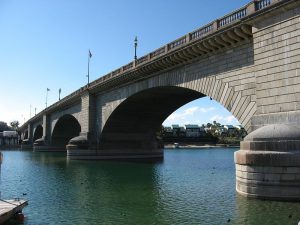
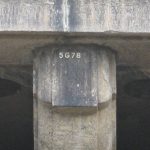 London Bridge there. Many people have made jokes about the intelligence of buyers, saying that if you’ll buy that, they have some ocean front property or even a bridge to sell you in Arizona. Well, I wouldn’t go for the ocean front property, which as we all know, doesn’t exist in Arizona, but the bridge is somewhat believable, although I doubt if this bridge is for sale, and if it was, I don’t know many people who could afford it. Nevertheless, it is a very unique landmark, and a very strange purchase, indeed.
London Bridge there. Many people have made jokes about the intelligence of buyers, saying that if you’ll buy that, they have some ocean front property or even a bridge to sell you in Arizona. Well, I wouldn’t go for the ocean front property, which as we all know, doesn’t exist in Arizona, but the bridge is somewhat believable, although I doubt if this bridge is for sale, and if it was, I don’t know many people who could afford it. Nevertheless, it is a very unique landmark, and a very strange purchase, indeed.
 Sometimes, you meet the love of your life the second time around. That’s how it was for my sister-in-law, Jennifer Parmely when she met her other half, Brian Cratty. These two are so much alike that they practically finish each other’s sentences. They have the same goals and they are going in the same direction with their lives. They have been a blessing in each other’s lives, and it is a sweet thing to watch.
Sometimes, you meet the love of your life the second time around. That’s how it was for my sister-in-law, Jennifer Parmely when she met her other half, Brian Cratty. These two are so much alike that they practically finish each other’s sentences. They have the same goals and they are going in the same direction with their lives. They have been a blessing in each other’s lives, and it is a sweet thing to watch.
Brian is rather a quiet guy, with a kind and loving spirit. I think he is most at home seated on his bicycle, weaving back an forth over the mountain trails. Brian and  Jennifer have a friend who owned a cabin on Casper Mountain, and then moved away. While he was gone, he asked them to keep an eye on his cabin, and in exchange, they could use it whenever they wanted. They jumped at the chance, and when their friend decided to sell the cabin, he offered it to them, and they were delighted to buy it. Anyone who has owned a cabin on the mountains, know that there is always this or that improvement to do, and so Brian and Jennifer have been doing lots of updates to it so that they and their family can enjoy the beautiful scenery of Casper Mountain. Since they bought the cabin, it is their home away from home…when they aren’t traveling, that is.
Jennifer have a friend who owned a cabin on Casper Mountain, and then moved away. While he was gone, he asked them to keep an eye on his cabin, and in exchange, they could use it whenever they wanted. They jumped at the chance, and when their friend decided to sell the cabin, he offered it to them, and they were delighted to buy it. Anyone who has owned a cabin on the mountains, know that there is always this or that improvement to do, and so Brian and Jennifer have been doing lots of updates to it so that they and their family can enjoy the beautiful scenery of Casper Mountain. Since they bought the cabin, it is their home away from home…when they aren’t traveling, that is.  Brian and Jennifer love to travel to areas of the United States where they can find new trails to hike and bike…as well as seeing the local sights.
Brian and Jennifer love to travel to areas of the United States where they can find new trails to hike and bike…as well as seeing the local sights.
Brian is a licensed pilot, but I don’t know how much flying he does these days. I’m sure it is enough to keep his license in place. He was a pilot for the Wyoming Medical Center until his retirement from there, but as any pilot would say, flying is in your blood, and you fly every chance you get. He has done corporate flying, but I think he just likes being retired for the most part. Today is Brian’s birthday. Happy birthday Brian!! Have a great day!! We love you!!
 Most of us think of Isaac Newton for things like Newtonian mechanics, Universal gravitation, Calculus, Newton’s laws of motion, Optics, Binomial series, Principa, and Newton’s method…ok, maybe not, I doubt if most of us know what most of that means, but we knew that he was a great mathematician. Newton was an English mathematician, but he was also a physicist, astronomer, theologian, and author who is widely recognized as one of the most influential scientists of all time, and a key figure in the scientific revolution.
Most of us think of Isaac Newton for things like Newtonian mechanics, Universal gravitation, Calculus, Newton’s laws of motion, Optics, Binomial series, Principa, and Newton’s method…ok, maybe not, I doubt if most of us know what most of that means, but we knew that he was a great mathematician. Newton was an English mathematician, but he was also a physicist, astronomer, theologian, and author who is widely recognized as one of the most influential scientists of all time, and a key figure in the scientific revolution.
Politically and personally, Newton was tied to the Whig party, an early version of the Republican Party. He served two brief terms as Member of Parliament for the University of Cambridge, in 1689-1690 and 1701-1702. He was noted by Cambridge diarist Abraham de la Pryme to have rebuked students who were frightening locals by claiming that a house was haunted. Newton moved to London to take up the post of warden of the Royal Mint in 1696, a position that he had obtained through the patronage of Charles Montagu, 1st Earl of Halifax, then Chancellor of the Exchequer. He took charge of England’s great recoining, trodden on the toes of Lord Lucas, Governor of the Tower, and secured the job of deputy comptroller of the temporary Chester branch for Edmond Halley. Newton became perhaps the best-known Master of the Mint upon the death of Thomas Neale in 1699. It was a position Newton held for the last 30 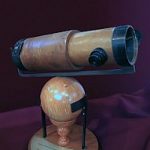 years of his life, and one of which he was very proud. These appointments were intended as type of figurehead position, but Newton took his job seriously. He retired from his Cambridge duties in 1701, and exercised his authority to reform the currency and punish clippers and counterfeiters. As Warden, and afterwards as Master, of the Royal Mint, Newton estimated that 20% of the coins taken in during the Great Recoinage of 1696 were counterfeit. Counterfeiting was high treason, which was punishable by the felon being hanged, drawn, and quartered. Despite that, it would be very difficult to convict even the most flagrant criminals. Nevertheless, Isaac Newton proved to be equal to the task.
years of his life, and one of which he was very proud. These appointments were intended as type of figurehead position, but Newton took his job seriously. He retired from his Cambridge duties in 1701, and exercised his authority to reform the currency and punish clippers and counterfeiters. As Warden, and afterwards as Master, of the Royal Mint, Newton estimated that 20% of the coins taken in during the Great Recoinage of 1696 were counterfeit. Counterfeiting was high treason, which was punishable by the felon being hanged, drawn, and quartered. Despite that, it would be very difficult to convict even the most flagrant criminals. Nevertheless, Isaac Newton proved to be equal to the task.
Disguised as a frequent patron of bars and taverns, he gathered much of that evidence himself. For all the barriers placed to prosecution, and separating the branches of government, English law still had ancient and formidable customs of authority. Newton had been made a justice of the peace in all the home counties. A draft letter regarding the matter is included in Newton’s personal first edition of Philosophiæ Naturalis Principia Mathematica, which he must have been amending at the time. Then he conducted more than 100 cross- examinations of witnesses, informers, and suspects between June 1698 and Christmas 1699. Newton successfully prosecuted 28 coiners. In April 1705, Queen Anne knighted Newton during a royal visit to Trinity College, Cambridge. The knighthood is likely to have been motivated by political considerations connected with the Parliamentary election in May 1705, rather than any recognition of Newton’s scientific work or services as Master of the Mint. Newton was the second scientist to be knighted, after Sir Francis Bacon. Newton died in his sleep in London on 20 March 1727. His body was buried in Westminster Abbey. A bachelor all his life, Newton had distributed much of his estate to relatives during his last years, and in the end, he died intestate. That seems, to me, a sad ending to an extraordinary life.
examinations of witnesses, informers, and suspects between June 1698 and Christmas 1699. Newton successfully prosecuted 28 coiners. In April 1705, Queen Anne knighted Newton during a royal visit to Trinity College, Cambridge. The knighthood is likely to have been motivated by political considerations connected with the Parliamentary election in May 1705, rather than any recognition of Newton’s scientific work or services as Master of the Mint. Newton was the second scientist to be knighted, after Sir Francis Bacon. Newton died in his sleep in London on 20 March 1727. His body was buried in Westminster Abbey. A bachelor all his life, Newton had distributed much of his estate to relatives during his last years, and in the end, he died intestate. That seems, to me, a sad ending to an extraordinary life.
 Fourteen years before the Titanic sank, Morgan Robertson wrote the novella Futility. It was about the large unsinkable ship “Titan” hitting an iceberg in the Northern Atlantic. Both the Titanic and the fictional Titan did not have enough lifeboats for the thousands of passengers on board. Both were short by about half. While the story behind the sinking of the Titan is somewhat different than the actual events of Titanic, the two are eerily similar, and with so many similarities, one has to wonder how this could have happened. It was like Robertson knew what was coming.
Fourteen years before the Titanic sank, Morgan Robertson wrote the novella Futility. It was about the large unsinkable ship “Titan” hitting an iceberg in the Northern Atlantic. Both the Titanic and the fictional Titan did not have enough lifeboats for the thousands of passengers on board. Both were short by about half. While the story behind the sinking of the Titan is somewhat different than the actual events of Titanic, the two are eerily similar, and with so many similarities, one has to wonder how this could have happened. It was like Robertson knew what was coming.
The story of the Titan puts the “unsinkable” ship sailing through the north Atlantic at breakneck speeds, because as we all know nothing could sink such a ship. Any breech of the holds would immediately close the water-tight doors, stopping the spillover into the other holds. As Titan sailed through the icy waters, they came into an area of fog, and still they did not slow down. Watchmen were posted, one of whom, John Rowland, tended to indulge in drink, since the love of his life left him, and now somehow was on the same ship, and she was married and had a child. While Rowland had been drinking, he was still the one to spot another ship…not that it made a difference. The titan continued full speed ahead, cutting the smaller vessel in half and killing all aboard. The ship still didn’t slow down, and the captain tried to buy the silence of his men, but Rowland would not be bought. As the trip continues, things just get worse. Before long, the ship hits an iceberg, and enough holds are breeched to seal Titan’s doom.
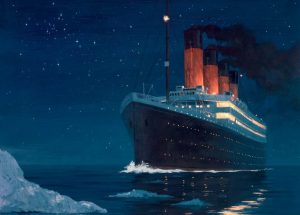 The book, “The Wreck of the Titan,” originally called “Futility,” was so similar to the events of the Titanic, that it was almost eerie, and yet, it was enough different that you knew it was not the same event. It was simply a “fact is stranger than fiction” situation, and no one could possibly have anticipated that a ship with a very similar name, loaded with people and half the necessary lifeboats, would sail at breakneck speeds across the north Atlantic during a time when the icebergs were floating everywhere, just like the ship in the story, and that the ship…Titanic would suffer the same fate as the storybook ship, Titan suffered, fourteen years after the author dreamed up the story in his mind. And yet that is exactly what happened.
The book, “The Wreck of the Titan,” originally called “Futility,” was so similar to the events of the Titanic, that it was almost eerie, and yet, it was enough different that you knew it was not the same event. It was simply a “fact is stranger than fiction” situation, and no one could possibly have anticipated that a ship with a very similar name, loaded with people and half the necessary lifeboats, would sail at breakneck speeds across the north Atlantic during a time when the icebergs were floating everywhere, just like the ship in the story, and that the ship…Titanic would suffer the same fate as the storybook ship, Titan suffered, fourteen years after the author dreamed up the story in his mind. And yet that is exactly what happened.
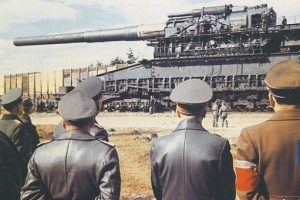 In 1934, Hitler had one problem…the French Maginot Line was the one thing standing in the way of Hitler invading France. In reality, it was the only thing that stood between Hitler and all of Western Europe. The French Maginot Line was a fortification running from the Rhine River to La Ferté consisting of concrete blockhouses, bunkers, and rail lines. The line was elaborate and extensive, and as rumors of its strength made their way to Germany, Hitler began to believe he’d need a miracle for his troops to break through it. Hitler believed that he needed the biggest gun in history.
In 1934, Hitler had one problem…the French Maginot Line was the one thing standing in the way of Hitler invading France. In reality, it was the only thing that stood between Hitler and all of Western Europe. The French Maginot Line was a fortification running from the Rhine River to La Ferté consisting of concrete blockhouses, bunkers, and rail lines. The line was elaborate and extensive, and as rumors of its strength made their way to Germany, Hitler began to believe he’d need a miracle for his troops to break through it. Hitler believed that he needed the biggest gun in history.
Engineers from Krupp, a steel company from Essen, were commissioned by the German High Command (OKH) to design a weapon powerful enough to break through the concrete fortifications that were nearing completion. The shells alone had to be strong enough to penetrate 22 feet of reinforced concrete and at least three feet of steel plating, meaning the weapon had to be massive. It had to be to hold and shoot shells large enough to bring such massive destruction. In order to meet the requirements that Hitler had set forth, Krupp engineer Erich Müller calculated that the weapon would have to be far bigger, and much more powerful than any weapon in existence. After much calculation, Müller put together the measurements for his goliath gun and presented the plan to the OKH.
Though Hitler made no formal commitment, the high command knew the design, known as the Schwerer Gustav, was their answer. With a caliber of 31 inches, able to fire a projectile that weighed more than 10 tons 30 miles away, the Schwerer Gustave was incredibly imposing. The barrel was over 100 feet long, longer than any gun barrel in existence, and the body of the gun was bigger than any tank to see battle so far. It was more like a small building than a gun. From the ground up it was almost four stories tall. It was over 150 feet long including the barrel, and weighed over 1,300 tons. To compare it to things of today, the Space Shuttle weighs 2,000 tons. This was no tiny tank. The shells alone, which had been designed with pure destruction in mind, were taller than two men, twice as wide as one, and weighed 20,000 pounds each. It took several men just to load one into the barrel. For the gun to move around, the body was built on two parallel sets of rail wheels, allowing it to travel across special tracks.
Ultimately, two of these weapons were ordered by the high command, the Schwerer Gustav and a smaller model they called “Dora.” However, the models weren’t ready by the time Hitler was, and the Germans were forced to invade France without them. Of course, they shouldn’t have been worried, as their troops far 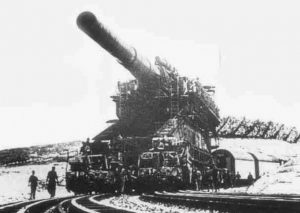 outnumbered the French’s static defenses. Even after the French quickly surrendered, Hitler still wanted to make use of his magnificent and destructive weapon. The siege of Sevastopol was the perfect opportunity. After five weeks of positioning the device, requiring 4,000 men, the weapon was ready. In five days, spanning between June 5 and June 17, the Schwerer Gustav fired 48 rounds, equaling 30,000 tons of ammunition. The barrel of the gun, which had already fired 250 rounds during testing, was worn out entirely. It took 500 men just to fire the gun, and after loading the oversized shells into the machine, they were exhausted. While the gun was daunting to anyone who saw it in action, it really wasn’t very practical.
outnumbered the French’s static defenses. Even after the French quickly surrendered, Hitler still wanted to make use of his magnificent and destructive weapon. The siege of Sevastopol was the perfect opportunity. After five weeks of positioning the device, requiring 4,000 men, the weapon was ready. In five days, spanning between June 5 and June 17, the Schwerer Gustav fired 48 rounds, equaling 30,000 tons of ammunition. The barrel of the gun, which had already fired 250 rounds during testing, was worn out entirely. It took 500 men just to fire the gun, and after loading the oversized shells into the machine, they were exhausted. While the gun was daunting to anyone who saw it in action, it really wasn’t very practical.
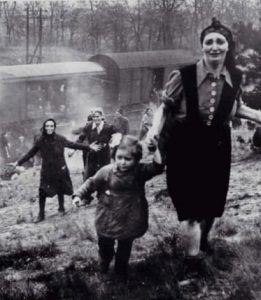 Friday, the 13th is not considered to be a lucky day…if you happen to be superstitious, but for almost 2500 Jewish people, as well as for Major Clarence L. Benjamin, Friday the 13th of April, 1945 would prove that Friday the 13th could be a very blessed day. While on a routine patrol a few miles northwest of Magdeburg, Benjamin and his unit came upon a railroad siding in a wooded ravine not far from the Elbe River. There, about 200 shabby looking civilians were sitting by the side of the road. Even in their shabby state, there was something immediately apparent about each one of these people, men and women, which drew immediate attention. These people were skeleton thin with starvation Their faces showed a sickness, and the way in which they stood…was like they were beaten and dejected, but there was something else. When they saw the Americans they began laughing in joy…if it could be called laughing. It was an outpouring of pure, near-hysterical relief. The reason, the unit soon found out was the railroad siding.
Friday, the 13th is not considered to be a lucky day…if you happen to be superstitious, but for almost 2500 Jewish people, as well as for Major Clarence L. Benjamin, Friday the 13th of April, 1945 would prove that Friday the 13th could be a very blessed day. While on a routine patrol a few miles northwest of Magdeburg, Benjamin and his unit came upon a railroad siding in a wooded ravine not far from the Elbe River. There, about 200 shabby looking civilians were sitting by the side of the road. Even in their shabby state, there was something immediately apparent about each one of these people, men and women, which drew immediate attention. These people were skeleton thin with starvation Their faces showed a sickness, and the way in which they stood…was like they were beaten and dejected, but there was something else. When they saw the Americans they began laughing in joy…if it could be called laughing. It was an outpouring of pure, near-hysterical relief. The reason, the unit soon found out was the railroad siding.
Standing silently on the tracks of the siding was a long string of grimy, ancient boxcars. On the banks by the tracks, trying to get some pitiful comfort from the thin April sun, sat a multitude of people of varying stages of misery. They sat motionless in despair. When they group sighted the Americans, a great stir went through this strange camp. Those who were able rushed toward the Major’s jeep and the two light tanks. On the hill to the left people were resting…some forever. About sixteen people died of starvation before food could be brought to the train. They simply couldn’t hold out any longer.
As the Major soothed the people, he eventually found some who spoke English, and their story came out. This had been, and still was, a horror train. This train which contained about 2,500 Jews, had a few days previously left the Bergen-Belsen death camp. Men, women and children, were all loaded into a few available railway cars, some passenger and some freight, but mostly the typical antiquated freight cars, called “40 and 8” cars. The term, from World War I, “40 and 8” meant that these cars would accommodate 40 men or 8 horses, but the cars were crammed with about 60 to 70 people, with standing room only for most of them. The cars were hot and it was hard to breathe. In all, the cars held about 2,500 Jews, far more than they should have.
The war was winding down, and the Nazis were trying to evacuate the concentration camps ahead of the Allied troops arrival. On April 10, 1945, three trains were sent from Bergen-Belsen with the purpose to move eastward from the Camp, to the Elbe River. They were told to reverse direction because of the rapidly advancing Russian Army. The train reversed direction and headed to Farsleben. There, they were then told that 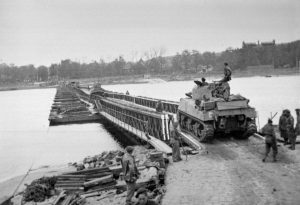 they were heading into the advancing American Army. The train halted at Farsleben…awaiting further orders. The engineers received their orders…drive the train to, and onto the bridge over the Elbe River, and either blow it up, or just drive it off the end of the damaged bridge, with all of the cars of the train crashing into the river, and killing or drowning all of the occupants. While the engineers thought about this action, knowing that they too would be hurtling themselves to death, the Americans caught up to them. The arrival of the 743rd Tank Battalion was the only reason anyone came out of the trains alive. It was Friday the 13th…a very blessed day for these Jews. Not an ounce of bad luck there.
they were heading into the advancing American Army. The train halted at Farsleben…awaiting further orders. The engineers received their orders…drive the train to, and onto the bridge over the Elbe River, and either blow it up, or just drive it off the end of the damaged bridge, with all of the cars of the train crashing into the river, and killing or drowning all of the occupants. While the engineers thought about this action, knowing that they too would be hurtling themselves to death, the Americans caught up to them. The arrival of the 743rd Tank Battalion was the only reason anyone came out of the trains alive. It was Friday the 13th…a very blessed day for these Jews. Not an ounce of bad luck there.
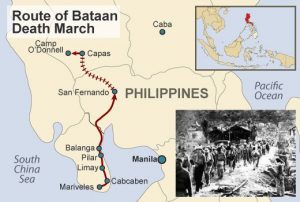 Following the attack on Pearl Harbor, the Japanese quickly began expanding their areas of control. They focused on the Philippine Islands, a United States territory, where tens of thousands of American and Filipino soldiers were stationed. The day after Japan bombed the US naval base at Pearl Harbor, on December 7, 1941, the Japanese invasion of the Philippines began. Without the necessary help from the US Navy, the troops stationed there quickly ran out of food and ammunition. On April 9, 1942, the soldiers had no choice but to surrender the Bataan Peninsula on the main Philippine island of Luzon to the Japanese. It was the largest army under US command ever to surrender.
Following the attack on Pearl Harbor, the Japanese quickly began expanding their areas of control. They focused on the Philippine Islands, a United States territory, where tens of thousands of American and Filipino soldiers were stationed. The day after Japan bombed the US naval base at Pearl Harbor, on December 7, 1941, the Japanese invasion of the Philippines began. Without the necessary help from the US Navy, the troops stationed there quickly ran out of food and ammunition. On April 9, 1942, the soldiers had no choice but to surrender the Bataan Peninsula on the main Philippine island of Luzon to the Japanese. It was the largest army under US command ever to surrender.
The Japanese didn’t want these prisoners of war to be visible, so a plan was devised to move them inland. The area didn’t have railways, and because they did not expect such a large group of surrendered soldiers, it was decided that they would walk the 65 miles. So, on April 9, 1942, 75,000 Filipino and American troops on Bataan were forced to make the torturous 65 mile march to Camp O’Donnell where they were to be housed. Japan was  completely unprepared for the sheer number of soldiers who surrendered that day. The Japanese troops were filled with frustration, coupled with disdain for surrendering troops, which led to shocking brutality during the march.
completely unprepared for the sheer number of soldiers who surrendered that day. The Japanese troops were filled with frustration, coupled with disdain for surrendering troops, which led to shocking brutality during the march.
The marchers made the trek in intense heat that further complicated their situation, along with the harsh treatment by the Japanese guards. Thousands of men died along the way, in what became known as the Bataan Death March. The march began at Mariveles, on the southern end of the Bataan Peninsula. It continued 65 miles to San Fernando. The men were divided into groups of approximately 100, and the march typically took each group around five days to complete. While no one knows for sure, it is believed that thousands of troops died because of the brutality of their captors, who starved and beat the marchers, giving them no food or water, and bayoneted those too weak to walk. Those who survived were taken by rail from San Fernando to prisoner-of-war camps, where thousands died from disease, mistreatment, and starvation.
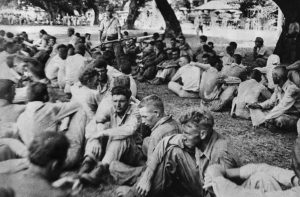 America was pulled into World War II after the attack on Pearl Harbor, and would later avenged its defeat in the Philippines with the invasion of the island of Leyte in October 1944. General Douglas MacArthur, who in 1942 had famously promised to return to the Philippines, made good on his word. In February 1945, US-Filipino forces recaptured the Bataan Peninsula, and Manila was liberated in early March. After the war, an American military tribunal tried Lieutenant General Homma Masaharu, commander of the Japanese invasion forces in the Philippines. He was held responsible for the death march, a war crime, and was executed by firing squad on April 3, 1946.
America was pulled into World War II after the attack on Pearl Harbor, and would later avenged its defeat in the Philippines with the invasion of the island of Leyte in October 1944. General Douglas MacArthur, who in 1942 had famously promised to return to the Philippines, made good on his word. In February 1945, US-Filipino forces recaptured the Bataan Peninsula, and Manila was liberated in early March. After the war, an American military tribunal tried Lieutenant General Homma Masaharu, commander of the Japanese invasion forces in the Philippines. He was held responsible for the death march, a war crime, and was executed by firing squad on April 3, 1946.
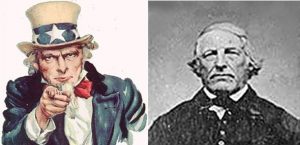 Everyone has heard the term, Uncle Sam used when referring to the United States government, but while the government and the people of the United States have “adopted” that term to mean the United States government, it was really never intended to be so. If you ask most people, the average older American would most likely point to the early 20th century and Sam’s frequent appearance on army recruitment posters. Nevertheless, the figure of Uncle Sam actually dates back much further than that. The actual figure of Uncle Sam, dates from the War of 1812. At that point, most American icons had been geographically specific, centering most often on the New England area. However, the War of 1812 sparked a renewed interest in national identity which had faded since the American Revolution.
Everyone has heard the term, Uncle Sam used when referring to the United States government, but while the government and the people of the United States have “adopted” that term to mean the United States government, it was really never intended to be so. If you ask most people, the average older American would most likely point to the early 20th century and Sam’s frequent appearance on army recruitment posters. Nevertheless, the figure of Uncle Sam actually dates back much further than that. The actual figure of Uncle Sam, dates from the War of 1812. At that point, most American icons had been geographically specific, centering most often on the New England area. However, the War of 1812 sparked a renewed interest in national identity which had faded since the American Revolution.
The term Uncle Sam was actually the nickname of a man named Samuel Wilson, who was a meat packer from Troy, New York. Sam supplied rations for the soldiers during the War of 1812. He had served in the American Revolution at the age of 15, and while he was born in Massachusetts, he relocated to the town of Troy, New York after the war. In Troy, Samuel and his brother, Ebenezer began the firm of E and S Wilson, a meat packing facility. Samuel was a man of great fairness, reliability, and honesty, who was devoted to his country. All of the local residents really liked Samuel, and they began calling him Uncle Sam.
During the War of 1812, the demand for meat supply for the troops was badly needed. Because he had been a soldier, Samuel had a soft spot in his heart for the soldiers. Secretary of War, William Eustis, made a contract with Elbert Anderson Jr of New York City to supply and issue all rations necessary for the United States forces in New York and New Jersey for one year. Anderson ran an advertisement on October 6, 1813 looking to fill the contract. The Wilson brothers bid for the contract and won. The contract was to fill 2,000 barrels of pork and 3,000 barrels of beef for one year. Their location on the Hudson River, made it ideal to receive the animals and to ship the product. As a security measure, the contractors were required to stamp their name and where the rations came from onto the food they were sending. Wilson’s packages bore the label “E.A. – US,” which stood for Elbert Anderson, the contractor, and the United States. When an individual in the meat packing facility asked what it stood for, a coworker joked and said it referred to Sam Wilson, Uncle Sam. A number of the soldiers were originally from Troy, and familiar with Samuel. When they saw the designation on the barrels, they, being acquainted with Sam Wilson and his nickname Uncle Sam, as well as the knowledge that Wilson was feeding the army, led them to the same conclusion. The local newspaper soon picked up on the story and Uncle Sam eventually gained widespread acceptance as the nickname for the U.S. federal government.
This is, of course, an endearing local story, and therefore, leaves some doubt as to whether it is the actual source of the term. Uncle Sam is mentioned previous to the War of 1812 in the popular song “Yankee Doodle,” which appeared in 1775. Nevertheless, the song doesn’t make it clear whether this reference is to Uncle Sam as a metaphor for the United States, or to an actual person named Sam. Another early reference to the term appeared in 1819, predating Wilson’s contract with the government. The connection between this local saying and the national legend is not easily traced. As early as 1830, there were inquiries into the origin of the term Uncle Sam. The connection between the popular cartoon figure and Samuel Wilson was reported in the New York Gazette on May 12, 1830. Whatever the source, Uncle Sam immediately became popular as a symbol of an ever-changing nation. His “likeness” appeared in drawings in various forms including resemblances to Brother Jonathan, a national personification and emblem of New England, and Abraham Lincoln, and others. In the late 1860s and 1870s, a political cartoonist named Thomas Nast began popularizing the image of Uncle Sam…building on the warm fuzzy feel of a beloved uncle. Nast continued to evolve the image, eventually giving Sam the white beard and stars-and-stripes suit that are associated with the character today.
However, it was a military recruiting poster, created in about 1917, that set the image of Uncle Sam was firmly set into American consciousness. The famous “I Want You” recruiting poster was created by James Montgomery Flagg and four million posters were printed between 1917 and 1918. The image was a really powerful one: 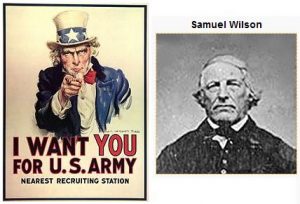 Uncle Sam’s striking features, expressive eyebrows, pointed finger, and direct address to the viewer made this drawing into an American icon. Throughout the years, Uncle Sam has appeared in advertising and on products ranging from cereal to coffee to car insurance. His likeness also continued to appear on military recruiting posters and in numerous political cartoons in newspapers. Finally, in September of 1961, the U.S. Congress recognized Samuel Wilson as “the progenitor of America’s national symbol of Uncle Sam.” Samuel Wilson died at age 88 in 1854, and was buried next to his wife Betsey Mann in the Oakwood Cemetery in Troy, New York. The town proudly calls itself “The Home of Uncle Sam.”
Uncle Sam’s striking features, expressive eyebrows, pointed finger, and direct address to the viewer made this drawing into an American icon. Throughout the years, Uncle Sam has appeared in advertising and on products ranging from cereal to coffee to car insurance. His likeness also continued to appear on military recruiting posters and in numerous political cartoons in newspapers. Finally, in September of 1961, the U.S. Congress recognized Samuel Wilson as “the progenitor of America’s national symbol of Uncle Sam.” Samuel Wilson died at age 88 in 1854, and was buried next to his wife Betsey Mann in the Oakwood Cemetery in Troy, New York. The town proudly calls itself “The Home of Uncle Sam.”
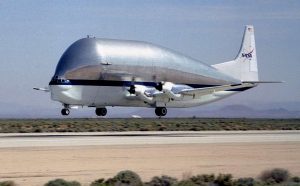 As airplanes go, we have seen many varieties over the years. Designs had to be streamlined in order to increase distance and improve fuel economy. The designs also had to provide increasing stability for longer flights, and to protect the people on board. I can understand design changes, and I know that they are necessary, but in the grand scheme of things, some of the different designs are not only strange, but downright humorous… and some were actually quite dangerous. Still, I guess everyone longs to design something new and different. Some of these planes may have had some purpose that I know nothing about, but I don’t think that many of them were very successful.
As airplanes go, we have seen many varieties over the years. Designs had to be streamlined in order to increase distance and improve fuel economy. The designs also had to provide increasing stability for longer flights, and to protect the people on board. I can understand design changes, and I know that they are necessary, but in the grand scheme of things, some of the different designs are not only strange, but downright humorous… and some were actually quite dangerous. Still, I guess everyone longs to design something new and different. Some of these planes may have had some purpose that I know nothing about, but I don’t think that many of them were very successful.
The B377PG, NASA’s Super Guppy Turbine Cargo Plane was first flown in 1980. It was nicknamed the “Pregnant Guppy” and was one of the most unique transports ever constructed. It was actually a modified Boeing 377 and it was the perfect hauler for those gigantic, weirdly shaped payloads that need to be transported cross-country in a hurry for some NASA project. It was originally commissioned by NASA to move the many components of the Apollo moon missions around. After the Apollo years, the Guppies were used 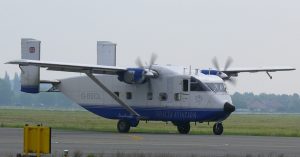 extensively by the private sector for years after the program was cancelled. To me it looks like a giant Airstream Travel trailer, and at first sight, its funny shape made me laugh.
extensively by the private sector for years after the program was cancelled. To me it looks like a giant Airstream Travel trailer, and at first sight, its funny shape made me laugh.
Another cargo plane that looked quite funny was the Short SC.7 Skyvan, which was nicknamed the “Flying Shoebox.” Manufactured by the Short Brothers in Belfast, Northern Ireland, the plane was a British 19-seat twin-turboprop aircraft. It is used for short-haul freight and skydiving. Its first flight was in January 1963. If you ask me, it barely looks like this plane could fly, but apparently it did so, quite well.
And then, there was the Caproni Ca.60 Transaereo, also known as “Capronissimo” and Noviplano Transaereo. On March 4, 1921 it tried to take off from Lake Maggiore with its nine, 30-meter-long wings. It barely seemed possible that this huge plane could win against gravity. It was similar in theme to crafts built by Icarus and Leonardo, who had already overcome gravity with hot air balloons, airships, and biplanes. I couldn’t imagine why they thought that such a monstrosity could fly, let alone land in one piece, nevertheless, Engineer Gianni 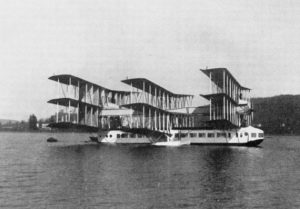 Caproni, wanted to prove that he could do it. So, with eight American 400-hp engines, 750 square meters of wings and 23 of fuselage, his gigantic hydroplane was over nine meters tall and weighed over 15,000 kilos when empty. It was designed to carry one hundred people across the Atlantic. The only problem was that the plane was simply too heave to manage a safe takeoff, much less a landing. The huge machine, with former military aviator Federico Semprini in the cabin, climbed too much in an effort to pull away from the flat waters of the lake and broke a few components, shattering Caproni’s dreams. I think it is very likely a good thing it never went further, because I’m not sure that such a frame could stand up to much windspeed.
Caproni, wanted to prove that he could do it. So, with eight American 400-hp engines, 750 square meters of wings and 23 of fuselage, his gigantic hydroplane was over nine meters tall and weighed over 15,000 kilos when empty. It was designed to carry one hundred people across the Atlantic. The only problem was that the plane was simply too heave to manage a safe takeoff, much less a landing. The huge machine, with former military aviator Federico Semprini in the cabin, climbed too much in an effort to pull away from the flat waters of the lake and broke a few components, shattering Caproni’s dreams. I think it is very likely a good thing it never went further, because I’m not sure that such a frame could stand up to much windspeed.

